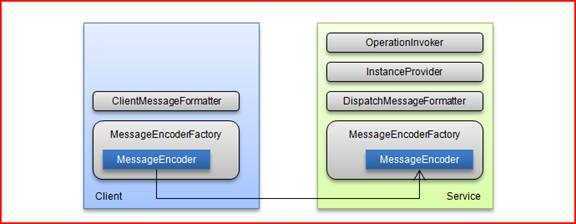标签:des style blog http io ar color os 使用
拜读了大牛蒋金楠的《WCF技术剖析之一:通过一个ASP.NET程序模拟WCF基础架构》,写点心得。
(原文:http://www.cnblogs.com/artech/archive/2009/06/18/1506163.html#!comments)
首先需要理解的是WCF的大致处理流程,设计到了哪些主要的类。下面的图片很好的诠释了处理流程。

代码上,作者在客户端和服务端分别创建了需要用来编码的Encoder和用来序列化/反序列化的DispatchFormatter,实际用到的类是DataContractSerializerOperationFormatter(看名字大概知道它是用来处理datacontract里的operationcontract,即方法的序列化/反序列化),并且建立了servicecontract的operationname/action name到相应的DispatchFormatter的字典,相当于客户端和服务端的约定。
结合代码一个个来看,首先看服务端:
1.接受request,然后Encoder对象会对request进行读取,解码,得到一个Message对象,Message的MessageHeaders包含一个重要的属性Action,后面会用到。
Message request = encoderFactory.Encoder.ReadMessage(this.Request.InputStream, int.MaxValue, "application/soap+xml;charset=utf-8");
2.接下来是反序列化,服务端要知道客户端想使用哪个service,哪个方法,传了什么参数,需要返回什么参数,返回什么结果。这些通过action可以得到,有了action,就能知道客户要调哪个method,要调哪个DispatchFormatter去反序列化。
string action = request.Headers.Action; MethodInfo method = methods[action]; int outArgsCount = 0; foreach (var parameter in method.GetParameters()) { if (parameter.IsOut) { outArgsCount++; } } int inputArgsCount = method.GetParameters().Length - outArgsCount; object[] parameters = new object[inputArgsCount]; try { dispatchFormatters[action].DeserializeRequest(request, parameters); } catch { }
3.DispatcherFormatter反序列化之后,应该是要create相应的service、method,传入parameter,然后invoke.这里action再次用来关联对应的DispatchFormatter和operationInvokers,但是对于serviceInstance,作者固定了是CalculatorService,不知实际情况是不是也来自于Message.
object serviceInstance = Activator.CreateInstance(typeof(CalculatorService)); object result = operationInvokers[action].Invoke(serviceInstance, parameters, out outArgs); Message reply = dispatchFormatters[action].SerializeReply(messageversion, outArgs, result);
4.执行完了operation之后,接下来要返回给客户端了,上一步,operation invoke的时候,把返回值,out parameter都序列化起来,也得到一个Message对象,
这个时候再调用Encoder进行编码,传递给Response.
this.Response.ClearContent(); this.Response.ContentEncoding = Encoding.UTF8; this.Response.ContentType = "application/soap+xml; charset=utf-8"; encoderFactory.Encoder.WriteMessage(reply, this.Response.OutputStream); this.Response.Flush();
服务端的任务大致是:从request流中Read(解码)出Message对象,Mesage对象包含了丰富的信息,服务端可以找到要请求的service,method,传入参数,要返回的类型,out参数等,然后DispatchFormatter进行反序列化,动态创建和执行,完了返回Message对象,Encoder再进行Write(编码到outputstream),然后返回。
再来看客户端代码:
客户端同样也会先创建好encoder, DispatchFormatter等,并且把operation name/action name做好字典关联。
1.客户端通过RealProxy的GetTransparentProxy()来返回servicecontract对象(这个不太明白?)
ICalculator calculator = SerivceProxyFactory<ICalculator>.Create( MessageVersion.Default, new Uri("http://localhost/Artech.WcfFrameworkSimulator/Calculator.aspx")); public static T Create(MessageVersion messageVersion,Uri remoteAddress) { MessageEncoderFactory encoderFactory; IDictionary<string, IClientMessageFormatter> clientFormatters; IDictionary<string, IDispatchMessageFormatter> dispatchFormatters; IDictionary<string, IOperationInvoker> operationInvokers; IDictionary<string, MethodInfo> methods; Utility.Create<T>(out encoderFactory,out clientFormatters,out dispatchFormatters,out operationInvokers,out methods); ServiceRealProxy<T> realProxy = new ServiceRealProxy<T>(messageVersion, remoteAddress, clientFormatters, encoderFactory); return (T) realProxy.GetTransparentProxy(); }
2.然后重写了RealProxy的Invoke方法来模拟wcf框架客户端做的一系列事情,下面这句话重要,当第2句执行时,第1句的methodCall得到调用的operationcontract,后面的都基于此发生。
IMethodCallMessage methodCall = (IMethodCallMessage)msg; double result = calculator.Add(1, 2);
3. 得到operationcontractattribute, 序列化消息,添加ws-address报头,编码等。
OperationContractAttribute attribute = (OperationContractAttribute)attributes[0]; string operationName = string.IsNullOrEmpty(attribute.Name) ? methodCall.MethodName : attribute.Name; //序列化请求消息 Message requestMessage = this._messageFormatters[operationName].SerializeRequest(this._messageVersion, methodCall.InArgs); //添加必要的WS-Address报头 EndpointAddress address = new EndpointAddress(this._remoteAddress); requestMessage.Headers.MessageId = new UniqueId(Guid.NewGuid()); requestMessage.Headers.ReplyTo = new EndpointAddress("http://www.w3.org/2005/08/addressing/anonymous"); address.ApplyTo(requestMessage); //对请求消息进行编码,并将编码生成的字节发送通过HttpWebRequest向服务端发送 HttpWebRequest webRequest = (HttpWebRequest)HttpWebRequest.Create(this._remoteAddress); webRequest.Method = "Post"; webRequest.KeepAlive = true; webRequest.ContentType = "application/soap+xml; charset=utf-8"; ArraySegment<byte> bytes = this._messageEncoderFactory.Encoder.WriteMessage(requestMessage, int.MaxValue, BufferManager.CreateBufferManager(long.MaxValue, int.MaxValue)); webRequest.ContentLength = bytes.Array.Length; webRequest.GetRequestStream().Write(bytes.Array, 0, bytes.Array.Length); webRequest.GetRequestStream().Close(); WebResponse webResponse = webRequest.GetResponse();
4.再然后是得到服务端的response,解码,反序列化,得到返回值和out/ref参数,最终完成调用。
//对HttpResponse进行解码生成回复消息. Message responseMessage = this._messageEncoderFactory.Encoder.ReadMessage(webResponse.GetResponseStream(), int.MaxValue); //回复消息进行反列化生成相应的对象,并映射为方法调用的返回值或者ref/out参数 object[] allArgs = (object[])Array.CreateInstance(typeof(object), methodCall.ArgCount); Array.Copy(methodCall.Args, allArgs, methodCall.ArgCount); object[] refOutParameters = new object[GetRefOutParameterCount(methodCall.MethodBase)]; object returnValue = this._messageFormatters[operationName].DeserializeReply(responseMessage, refOutParameters); MapRefOutParameter(methodCall.MethodBase, allArgs, refOutParameters); //通过ReturnMessage的形式将返回值和ref/out参数返回 return new ReturnMessage(returnValue, allArgs, allArgs.Length, methodCall.LogicalCallContext, methodCall);
标签:des style blog http io ar color os 使用
原文地址:http://www.cnblogs.com/Cyzin11/p/4121650.html